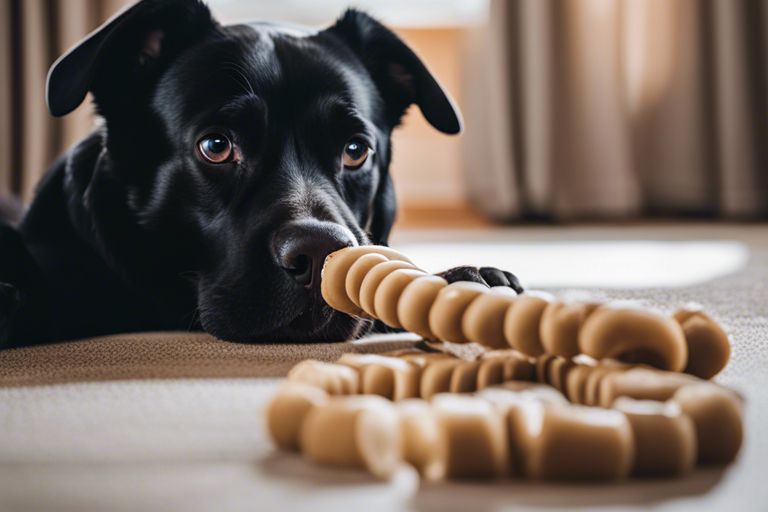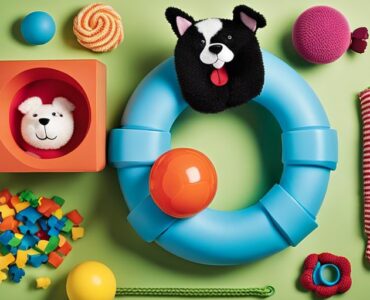While rawhide toys may seem like a popular choice for many dog owners, there are potential dangers associated with giving these chewing products to our furry companions. Many pet owners are not aware of the risks that come with giving rawhide toys to their pets. From choking hazards to digestive issues, there are several serious concerns that every dog owner should be aware of when it comes to rawhide toys. In this blog post, we will dive into the potential dangers of rawhide toys and explore safer alternatives for satisfying your dog’s chewing instincts. It is important to be well-informed about the potential hazards and make the best choices for our beloved pets.
Table of Contents
Key Takeaways:
- Choking Hazard: Rawhide toys can pose a choking hazard to dogs, especially if the pieces are not appropriately sized or if the dog is an aggressive chewer.
- Digestive Issues: Dogs can suffer from digestive problems such as vomiting, diarrhea, and blockages if they swallow large pieces of rawhide.
- Bacterial Contamination: Rawhide toys can be contaminated with bacteria such as Salmonella and E. coli, which can make dogs sick if they ingest the contaminated rawhide.
- Allergic Reactions: Some dogs may be allergic to the chemicals and preservatives used to process and treat rawhide, leading to skin irritations or other allergic reactions.
- Alternative Options: There are safer chew toy options available, such as natural rubber chew toys, nylon bones, or dental chews, that can provide a safer alternative to rawhide toys for dogs.
What is Rawhide?
Obviously, rawhide is a popular type of dog chew that is made from the inner layer of cow or horse hides. It is often used to keep dogs entertained, alleviate teething pain, and promote dental health. Rawhide chews come in various shapes and sizes, and are widely available at pet stores and online retailers. Safer Rawhide Chews for Dogs are also an option for pet owners concerned about potential dangers associated with traditional rawhide.
Origin and Manufacture
Manufacture of rawhide involves stripping the top layer of the hide to remove hair and fat, then the inner layer is cut or ground into shapes, and finally it is dried. The process can vary between manufacturers, and some may use chemicals or additives to preserve or enhance the rawhide.
Prevalence in Dog Ownership
On average, many dog owners give their pets rawhide chews as a form of entertainment or to promote dental health. This is especially true for those with teething puppies or dogs that are especially prone to chewing behaviors. However, some pet owners may not be aware of the potential risks associated with rawhide.
This can pose a potential danger not only to the health and safety of dogs, but also to the peace of mind of their owners. Therefore, it’s important to educate oneself about the risks and benefits of giving dogs rawhide chews. Proper awareness and understanding can lead to better decision-making when it comes to choosing appropriate chew products for beloved canine companions.
Potential Benefits of Rawhide Toys
Some pet owners swear by rawhide toys as a great way to keep their dogs entertained and healthy. While there are certainly some dangers associated with giving dogs rawhide toys, there are also potential benefits to consider.
Dental Health
One potential benefit of rawhide toys is the promotion of good dental health in dogs. Chewing on rawhide toys can help to scrape away plaque and tartar buildup, which may reduce the risk of dental issues such as gum disease and tooth decay. Additionally, the act of chewing on rawhide can help to strengthen a dog’s jaw and keep their teeth clean and strong.
Mental Stimulation and Stress Relief
One of the main benefits of rawhide toys is the mental stimulation and stress relief they can provide for dogs. Chewing on a rawhide toy can help to alleviate boredom and anxiety in dogs, keeping their minds engaged and providing an outlet for excess energy. This can be particularly beneficial for dogs that are left alone for long periods of time or that suffer from separation anxiety.
Mental stimulation and stress relief are important aspects of a dog’s overall well-being, and rawhide toys can contribute to a healthier and happier pup.
Risks Associated with Rawhide Toys
Despite the popularity of rawhide toys as a chew toy for dogs, there are several risks associated with giving them to your furry friends.
Choking Hazards
With their hard texture, rawhide toys can pose a choking hazard for dogs, especially for smaller breeds. Chunks of the toy can break off and become lodged in the dog’s throat, leading to potential asphyxiation.
Digestive Complications
Complications can arise when dogs ingest pieces of rawhide toys that are too large to pass through their digestive system. This can lead to blockages and potential surgical intervention to remove the obstruction.
A visit to the veterinarian may be necessary if a dog experiences symptoms such as vomiting, diarrhea, or lethargy after consuming rawhide.
Chemical Contamination
Rawhide toys are often treated with chemicals to preserve and color them. This can lead to toxic reactions in dogs if they consume or come into contact with these harmful substances.
Chemical contamination can result in symptoms such as digestive upset, neurological issues, or skin irritation in dogs.
Blockages and Surgery
An untreated blockage in a dog’s digestive system can lead to the need for surgical removal of the obstruction. This procedure can be costly and traumatic for both the dog and their owner.
This emphasizes the importance of monitoring your dog’s playtime and toy consumption to prevent the risk of blockages and the need for surgery.
Alternatives to Rawhide
Chemical-free chew toys made from natural materials, such as rubber or nylon, can provide safer alternatives to rawhide toys. These products are designed to withstand powerful chewing and are less likely to cause digestive issues or chemical exposure.
The use of healthy and safe chew toys can provide peace of mind for dog owners while ensuring their pets’ safety during playtime.
Safe Usage and Recommendations
Not all rawhide toys are created equal, and it’s important for dog owners to be aware of the potential dangers associated with giving their dogs these toys. However, with proper precautions and monitoring, rawhide toys can be used safely and can provide benefits for dogs’ dental health and enjoyment.
Selecting the Right Rawhide
An important factor in ensuring the safety of rawhide toys is to carefully select the right type and size for your dogs. Choose rawhide toys that are specifically labeled as natural and free of harmful chemicals or additives. Additionally, consider the size and thickness of the rawhide toy to ensure it is appropriate for your dogs to avoid choking or digestive issues.
Monitoring Your Dog’s Chew Time
Dogs should always be supervised when chewing on rawhide toys to prevent any potential hazards. Monitor your dogs’ chew time to ensure they are not consuming large pieces of rawhide or attempting to swallow the toy whole. Remove any small or broken pieces of rawhide to prevent choking or intestinal blockage.
The frequency and duration of chewing sessions should also be controlled to prevent excessive wear on your dogs’ teeth and potential jaw and digestive issues.
Recognizing When to Discard Rawhide Toys
An important aspect of safe usage is knowing when to discard rawhide toys. As the toy becomes small enough to be a choking hazard, or if it becomes soggy or starts to break apart, it should be immediately removed and discarded. Additionally, if your dogs show signs of digestive discomfort or have trouble passing stool after chewing on a rawhide toy, it’s time to discard it and consult with a veterinarian.
With proper attention and regularly replacing rawhide toys, dogs can enjoy the benefits of chewing on these toys without experiencing any negative effects on their health.
Are there dangers to giving dogs rawhide toys?
To wrap up, it is important to be aware of the potential dangers of giving dogs rawhide toys. While many dogs enjoy chewing on rawhide and it can be beneficial for their dental health, there are risks associated with this type of toy. These dangers include choking, gastrointestinal blockages, and potential exposure to harmful chemicals used in the processing of rawhide. It is important for pet owners to closely supervise their dogs when giving them rawhide toys and to consider safer alternatives such as natural rubber or nylon chew toys. Additionally, consulting with a veterinarian can provide valuable insight into which types of toys are best suited for a specific dog’s needs.
FAQ
Q: Are rawhide toys dangerous for dogs?
A: Yes, rawhide toys can pose several risks to dogs. These risks include choking, intestinal blockages, and potential contamination with bacteria or chemicals.
Q: What are the dangers of rawhide toys for dogs?
A: Rawhide toys can present a choking hazard if large pieces are swallowed. Additionally, ingesting rawhide can lead to intestinal blockages, causing severe discomfort or even require surgical intervention. There have also been cases of rawhide being contaminated with bacteria or chemicals, posing health risks to dogs.
Q: How can I safely give my dog rawhide toys?
A: It is important to choose the right size and type of rawhide toy for your dog. Opt for rawhide toys that are appropriately sized for your dog and monitor them while they are chewing. It’s also crucial to purchase rawhide toys from reputable sources to ensure they are free from contaminants. If you have any concerns about the safety of rawhide toys, consider alternative chew toys such as rubber or nylon options.











Add comment